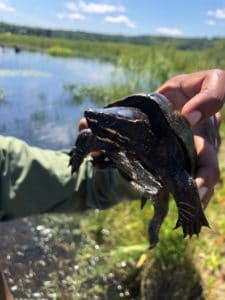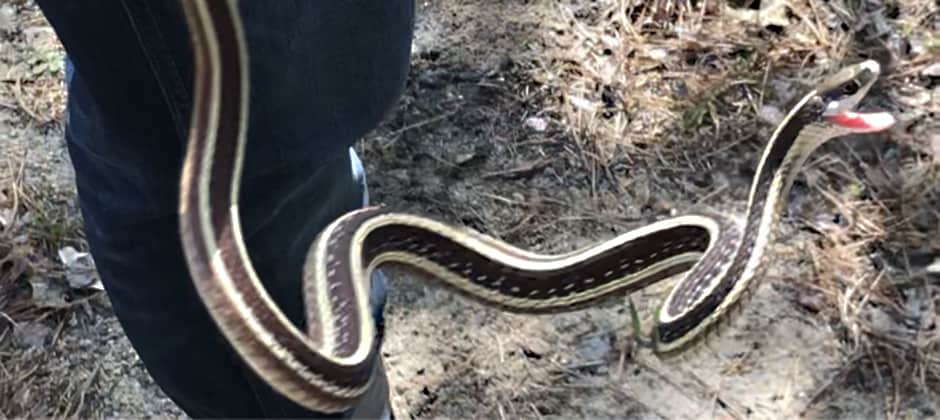Share this article
For amphibians and reptiles, wetlands restoration takes time
Restored cranberry farm environments don’t immediately attract large numbers of native amphibians and reptiles or initially promote species diversity of native amphibians and reptiles, according to preliminary results presented in a poster session at the 2019 Joint Annual Conference of the American Fisheries Society and The Wildlife Society in October.
Regina Christen, an undergraduate biology student at Bridgewater State University and a TWS student member along with her colleagues Ally Dewey and Alexis Gouthro examined reptile and amphibian abundance and species diversity in a large cranberry farm complex spanning over 480 acres. Half of the farm was restored between 2010 and 2015 in what Christen calls the largest freshwater ecological restoration project in the Northeast. The other half remains unrestored (see photos of the difference between both environments here).
While the study is ongoing, researchers found that restoration efforts didn’t result in more amphibians or reptiles, or greater species diversity. Instead, researchers are finding that unrestored wetlands had far more amphibians and greater amphibian diversity while reptile numbers seemed to be the same in either spot.
“Overall there are no significant differences in abundance or species richness in reptiles,” Christen said.
For reptiles, they saw species like eastern painted turtles (Chrysemys picta), common musk turtles (Sternotherus odoratus) and common snapping turtles (Chelydra serpentine) in the same abundance in both unrestored and restored areas, while species of conservation concern, such as eastern box turtles (Terrapene carolina carolina) and red-bellied cooters (Pseudemys rubriventris) didn’t turn up in surveys at either place. They also found similar abundances of snake species, including eastern ribbon snakes (Thamnophis sauritus sauritus), eastern garter snakes (Thamnophis sirtalis) and northern red-bellied snakes (Storeria occipitomaculata occipitomaculata) in similar numbers in both survey areas.
For amphibians, they found that unrestored wetlands had more individuals and more species richness than the restored areas.

Musk turtles, dietary generalists, were found at both types of sites while neither had rarer turtle species like eastern box turtles or red-bellied cooters. © Yacoub Dobeib
Christen said that the surprising difference in numbers with amphibians may be due to the fact that the restored areas were only returned to more natural states recently. The process of restoration involves a level of environment disturbance, which may have also contributed to lesser numbers of amphibians at the restored sites, compared to the already established populations of amphibians in the unrestored site.
It may take time for amphibians and reptiles of conservation concern like red-bellied cooters and eastern box turtles to colonize restored sites. The reptiles and amphibians they found in both areas are habitat and diet generalists, so they may be less sensitive to recent restoration disturbance compared to habitat specialist species, or to living in cranberry farm areas in general.
These generalist reptiles may disperse quickly to suitable habitats, Christen said, which would explain why those reptiles appear in equal numbers in the restored areas. Existing unrestored sites already provide suitable habitats for amphibians, but with time, Christen said, amphibians may increase in number in restored sites.
Turtles were only found in irrigation channels in the unrestored sites, but in the restored area, they weren’t found in these sites at all. Christen said that while their research is ongoing, this could mean that these creatures only use these less than ideal areas in marginal environments because these areas are their only option. But in the restored sites, the reptiles appeared more often in restored ponds and weren’t found in irrigation channels still left in the area.
The good news, she said, was that invasive species often found in Massachusetts, like red-eared sliders (Trachemys scripta elegans) and red-bellied sliders (Trachemys scripta elegans), weren’t found at either restored areas or unrestored areas.
Header Image:
Ribbon snakes were found in equal numbers at both restored and unrestored cranberry farm areas.
© Regina Christen








